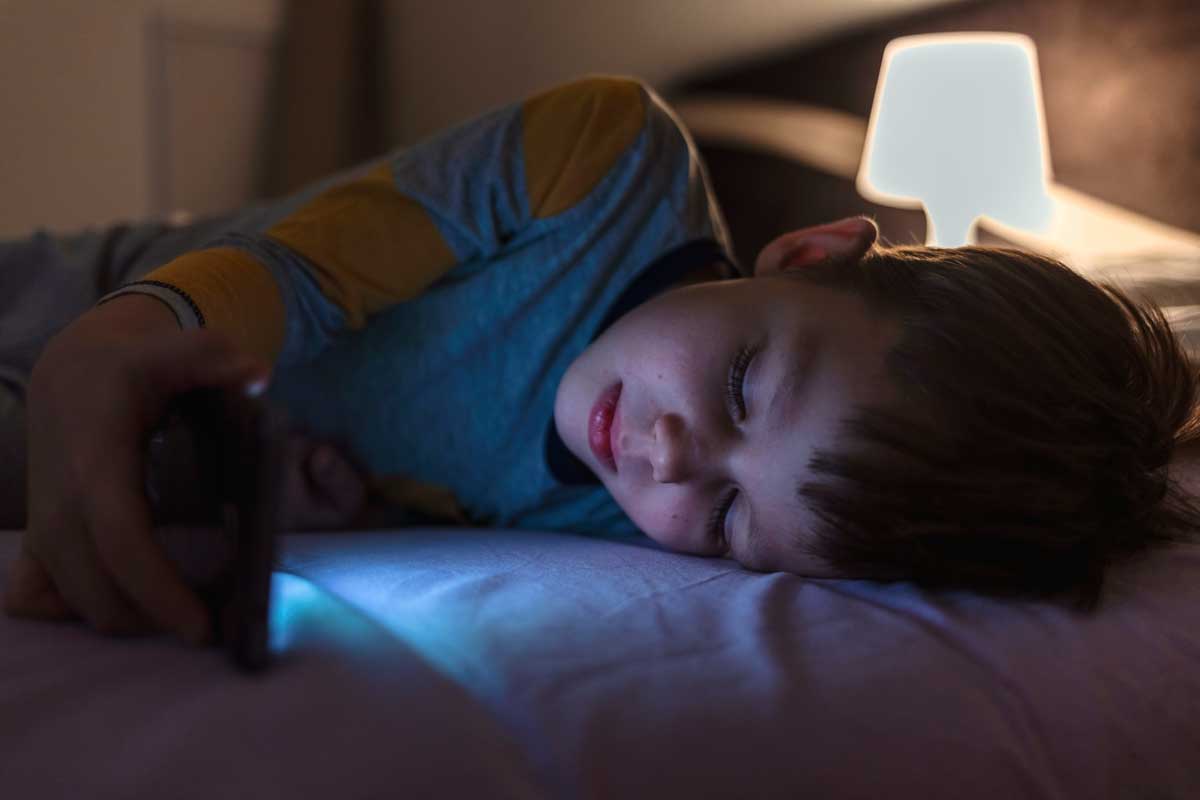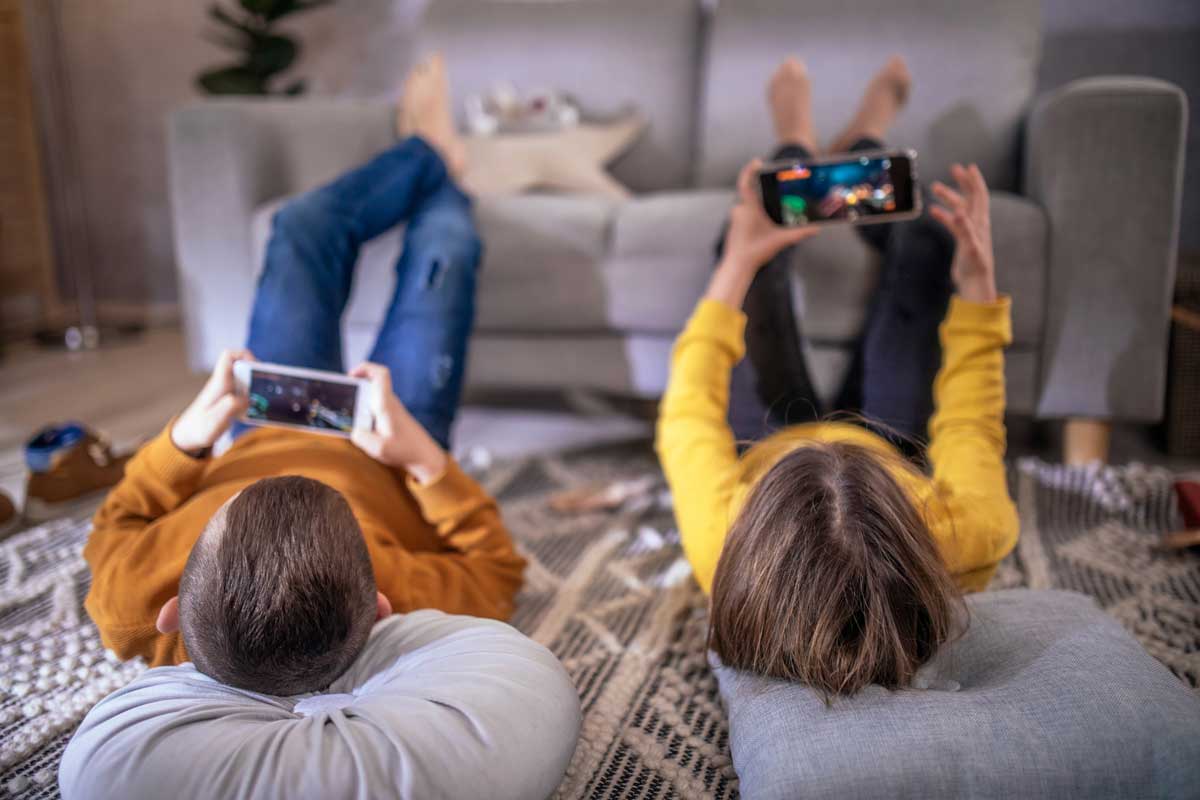Sober Kids Canada
For Parents
Digital Media – Questions and Answers


Screen Time and Youth
What is screen time and digital media?
Screen time and digital media are ‘joined at the hip’. Screen time is any time spent looking at a screen such as a tablet, smartphone or television. The term “digital media” means any content that is passed on or communicated over the internet or a computer network. 74
What is the recommended screen time for children under 2 years old?
There are differing views on the amount/type of screen time for very young children. However, most research indicates screen time should be avoided for infants/very young children, and only be allowed in limited amounts as they age. Some examples of professional guidance are as follows:
- The Canadian Pediatric Society recommends zero screen time for children under two (2) years of age. 75
- The American Academy of Child and Adolescent Psychiatry (AACAP) notes for kids under 18 months of age, screen time should be limited to video conversations with an adult (for example, a parent on vacation can video chat with parent at home with child).
- AACAP also notes that for children between the ages of 18-24 months, screen time should be limited to watching educational programs with a caregiver present during viewing. 76
What is the recommended screen time for children aged 2 to 5 years old?
For children ages 2 to 5, the Canadian pediatric society recommends limiting screen time to less than 1 hour per day.
The American Academy of Child and Adolescent Psychiatry (AACAP) similarly notes that for the ages of 2-5, non-educational screen time should be limited to approximately 1 hour per weekday and no more than 3 hours on weekend days.
What are the potential negative impacts of screen time for young children (under 5 years old)?
Younger children are more at risk to the adverse impacts of screen time than older children. Early periods of a child’s life (particularly ages 0-3) are critical for many important areas of brain development. Screen time can have the following negative consequences for young children:
- Decreased intellectual functioning and language skills – Infants and toddlers need to learn basic skills such as understanding language and facial recognition. Infants and toddlers who are exposed to significant amounts of screen time can suffer from delays in learning language skills. Similarly, younger children who watch significant amounts of television have been shown to have negative changes in brain development/decreased intellectual functioning. 77
- Poor motor skills – Young children who engage in too much screen time have less developed motor skills vs. their peers who do not use screens. These children can have more difficulty with basic functions such as walking or running. 78
- Poor sleep – Research has also shown a correlation between higher levels of screen time and sleep problems in young children. The more screen time a young child has the more likely they are to experience shorter sleep times and more awakening throughout the night. 79
- Increased risk of ADHD (attention-deficit/hyperactivity disorder) – Younger children who overuse screens are at increased risk of developing symptoms of ADHD. Similarly, children with ADHD who spend excessive time on screens may find their symptoms worsening as a result. 80
- Obesity – excessive screen time in children under the age of 5 contributes to childhood obesity. For example, research indicates that children who watch one hour of television per day have a 50% higher chance of being overweight compared to children who watch less than an hour of TV per day. 81
What types of screen time are healthier for younger kids (ages 2-5)?
Screen time which involves problem-solving and educational content is healthier for young children (ages 2-5) than passive screen time. For example, apps which help children learn math and language skills where the child engages with questions and answers will be more healthy/beneficial than a child sitting and passively watching a television show for an hour. Children can also learn language skills by observing and interacting with some types of screen content.
This said, many skills (such as social engagement and language skills) are best learned through interaction with adults. While there are benefits to active screen time, an excess of either passive or active screen time can be associated with language delays, sleep disorders and attention deficits. 82
What is the recommended screen time for children/youth over age 5?
The Canadian Pediatric Society recommends that children older than five should limit screen time to less than two hours per day.
What are the potential negative impacts of screen time for teens and children over 5?
Too much screen time can have negative impacts on the health of older children and teens. These include the following:
- Depression and anxiety – Canadian research shows that teens who use screen time in excess of 2 hours per day are at significantly increased risk of suffering from anxiety and depression. 83
- Increased risk of self-harm – Youth who engage in overuse of screens and digital media are at increased risk for self-harming behaviours. A study in the United Kingdom, with an average age of participants being 13.75 years old, found that teens who overuse social media and screens generally are more likely to suffer from depression and more likely to harm themselves. 84
- Interfering with social bonding/healthy relationships with others – youth who engage in over two hours of screen time per day are less likely to form healthy attachments and personal relationships with others. Lack of healthy attachment to peers and friends contributes to mood problems.
- Negative self-body image – teens who engage in excessive screen time are at increased risk of being exposed to unrealistic body images. This can cause a teen to have a negative image of their own body which in turn contributes to anxiety and depression.
- ADHD/Symptoms of ADHD – youth and children who engage in excessive screen time often demonstrate symptoms of ADHD (attention-deficit/hyperactivity disorder). Symptoms associated with this condition include difficulty focusing, being hyperactive (excessive movement) and being impulsive. There are also cases where even if the child does not have a diagnosable condition of ADHD, they may have the symptoms of this condition if they overuse screens and digital media. 85
- Poor sleep – Overuse of screens by adolescents has a negative impact on teens’ sleep. Teens who are on the Internet excessively (or closer to bedtime) are shown to have shorter periods of sleep as well as poor quality sleep. Specifically, the light from screens on phones, computers or tablets before bed often triggers insomnia symptoms. 86
- Obesity – teens who overuse screens and digital media are at increased risk for obesity and are more likely to overeat. 87

Smartphones, Screens, and Youth – Tools for Parents
When should I give my kid a smartphone/cell phone?
Some experts and child advocates recommend that a child/teen should not have a smartphone until the 8th grade or age 14. 104
For example, the U.S. based charity “Wait Until 8th” notes that smartphones are addictive for teens and can interfere with academic development/success. This is backed up by studies which show that kids who spend 2 hours per day or more on screens get lower scores on thinking and language tests. 105
Parents/Kids need to communicate – are there alternatives to smartphones?
In today’s digital world, busy parents and kids often need to communicate quickly. There are alternatives which allow texting and voice communications without the negative screen impacts of smartphone use. Watches such as Garmin Bounce, Gizmo Watch and Gabb Watch allow kids to communicate with parents and other contacts by way of text messaging and voice applications. Parents do not need the watch themselves, as the kids’ watch communications are directed to the parents through a smartphone app.
Kids aged 0-2: What can parents do to prevent harm from Smartphones, Social-Media and Screens?
For very young children (under 2 years of age) the best thing parents can do is to avoid use of screens for children under the age of 2. Healthy exceptions would include parents/children communicating through video chat with relatives.
Kids aged 2-5 – What can parents do to prevent harm from Smartphones, Social-Media and Screens?
Parents of children in the age group 2-5 can take the following steps to limit potential harms to children (and take advantage of some of the benefits):
- Limit any screen time to 1 hour per day, use a timer and log amounts of time to make sure limits are being observed
- Supervise younger children while they are using a screen so you are aware of the content they are observing
- Focus use of screen time on active vs. passive screen time. Active screen time on apps/content that involve the active participation of a child can be helpful for the development of language and mathematical skills. There are many helpful education apps where kids can engage with the content to learn basic math and language development.
Kids Ages 5-12 – What can parents do to prevent harm from Smartphones, Social-Media and Screens?
Parents can take the following steps to limit digital harms for kids 5-12:
- Know the facts and talk about ‘balance’: Educating your kids on the benefits and harms of screens from a young age onward will give them the best chance to make good choices about screen use. Talk to your kids about balance, and the importance of having non-screen time vs. screen time. An example would be as follows: “We’ve had an hour of video games today, time to shut this off now and make sure we have balance”. 106
- Limit screen time use to 2 hours per day and establish specific times during the day when your child can use screens.
- Monitor what your children are watching/doing on screens. Educational screen time has potential benefits and less harm than passive screen time.
- For movies or TV shows, preview what your children are watching before they do. Tools such as “Common Sense Media” give parents an overview/rating for popular shows and movies with age recommendations.
- At bedtime, remove any screens from child’s bedroom or prohibit use before bed. Children should avoid using screens for 30-60 minutes before bedtime. 107
- Family Rules/Boundaries – have rules/boundaries for family times that are screen free such as family mealtime or outside play.
- Lead by way of example – kids look to parents to define “normal” screen use. Limit use of smartphones/screens when spending time with your children at home.
- Do not permit your child 12 and under to have a social media account.
- Delay giving your child a smartphone/cell phone – some experts recommend that children should not have a smartphone until the 8th grade. Smartphone ownership by younger kids or young teens is usually associated with significantly higher screen time use generally. 108 The more time a teen spends on screens the greater the risk of having negative mental health outcomes.
- Use alternatives to smartphones to communicate via text and voice – There are many great alternatives that allow kids to communicate with their parents without having access to most smartphone screen apps. These devices include Garmin Bounce watch, Gizmo Watch and Gabb Watch.
- Use apps/programs that allow you to monitor your child’s screen time use. Apps such as Apple Screen Time, Google Family Link and Qustodio are excellent tools parents can use to follow and track time for what their kids are looking at. The following articles provide excellent summaries for popular apps/programs used by parents:
The Best Parental Control Apps to Manage Screen Time (and Keep Your Kid Safer Online)
Teens - Ages 13+ - What can parents do to prevent harm from Smartphones, Social-Media and Screens?
The following is a list of suggestions/tools parents’ can use to limit potential harms to their teens:
- Try and limit screen time use to 2 hours per day. Here, we are talking about non-educational screen use, such as most social media use, video gaming, watching TV etc. This time limit suggestion does not include teens’ using computers/media at school for educational purposes or teens doing homework on a computer. The main potential for harm is non-educational screen use.
- Monitor teen social media use, and limit the use of certain types of platforms, specifically those that try and increase usage time with algorithms based on “likes”, and approval/disapproval of content, posts etc.
- Review settings on social media accounts Most social media accounts have settings that monitor time spent using. Activate these settings and review them regularly for your teen’s account. Similarly, review privacy settings on the platform and ensure they are age appropriate. The selection of higher privacy levels makes it harder for strangers to you’re your teen’s information and makes it less likely a stranger will be able to contact them.
- For social media, make sure your teens’ age/date of birth is correctly reported in their account. Many well-known platforms have safety mechanisms built in for younger users, including limiting types of content and auto-privacy settings that minimize risks of a child being contacted by strangers.
- Use apps/programs that allow you to monitor your child’s screen time use. Apps such as Apple Screen Time, Google Family Link and Qustodio are excellent tools parents’ can use in this regard. The following articles provide excellent summaries for popular apps/programs used by parents:
The Best Parental Control Apps to Manage Screen Time (and Keep Your Kid Safer Online)
7 Apps That Help Control Screen Time
- Know the facts/Educate your teens: Educating your kids on the benefits and harms of digital media will give them the best chance to make good choices about screen use. For example, you can explain how overuse of social media/screens is linked with anxiety and depression, or how body images on social media are unrealistic and can lead to self-criticism.
- Talk to your kids about balance, and the importance of having non-screen time vs. screen time. An example would be as follows: “We’ve had an hour of video games today, time to shut this off now and make sure we have balance”. 106
- Family Rules/Boundaries – have rules/boundaries for family times that are screen free such as mealtime or outside play.
- Lead by way of example – kids’ look to parents to define “normal” screen use. Limit use of smartphones/screens when spending time with your children at home.
Join our mission. Volunteer, Donate, Advocate. Get Started Today.
Email: info@soberkids.ca
Phone: 403-450-0029








Social Media and Youth
What is social media?
Social media is a broad term that includes platforms and apps that allow users to engage with each other socially. Some examples of social media platforms and apps are as follows:
Are there any age limits for kids starting to use social media?
Most social media platforms require users to be at least 13 years old to sign up. 88
Other experts also support the idea that children under 13 should not be permitted access to social media. 89
Evidence suggests these age limits are largely being ignored. For example, in the U.S., nearly 40% of children ages 8-12 actively use social media platforms. 90
What are the potential benefits of social media for teens?
There are many potential benefits for teens who use social media. These include the following:
Teens and body image: What are the negative impacts of social media?
Social media use can have a negative impact on how teens view their bodies. On certain platforms, teens are presented with an unrealistic view of what constitutes a ‘normal’ body type. Research shows a link between social media use and poor self-body image in adolescents.
Teens viewing social media often compare their own bodies with others whose body type (or image of body type presented) is not the ‘norm’ or average in society. This in turn can lead to dissatisfaction with one’s own body, which in turn contributes to eating disorders and symptoms of depression 92
In a comprehensive survey of teens between the ages of 13-17, almost half (46%) of those surveyed noted that social media made them feel worse about their own bodies. In contrast, only 14% felt that social media use helped them to feel better about their body image. 94
Are children/teens who use social media at risk of being contacted by predators?
Predators often use social media to try and exploit youth. There are numerous cases where adults will hide their identity/age and pretend to be a child or teen to connect with a real young person for malicious purposes. After making a connection with a child/teen, these dangerous adults will often try and create a bond of trust by giving fake compliments and validation. 95
Once a connection is made between a predator and a teen, many potential dangers can occur, including the following:
Is social media addictive?
There is debate as to whether overuse of technology fits the medical diagnosis for “addiction”. This said, regardless of its official title, research indicates that many children/teens feel ‘hooked’ on using social media. This is demonstrated by the large number of hours kids spend using these platforms.
In Canada, research in Ontario and Alberta suggests high school students spend 5 hours or more each day using social media. 98
In a 2023 Common Sense Media national (US) survey, U.S. one-third of girls aged 11-15 years felt they were “addicted” to a social media. 99
Similarly, a survey of kids in grades 8-10 showed kids spending an average of 3.5 hours per day on social media. 1 in 4 of these kids spend 5+ hours per day on social media, while 1-7 of these children spent over 7 hours per day on social media. 100
Why are some kids feeling ‘hooked’ on social media?
Part of the reason some kids feel ‘hooked’ on social media is a because these platforms are created to draw people into using them excessively. Social Media companies use algorithms that leverage the data of those using their services to try and maximize time spent/engagement with their platform. Algorithms are data and rules for platforms that determine what content is presented to users of these platforms. 101 The aim of these algorithms is to try and keep the user engaged with the social media site for as long as possible. In other words, platforms take user data and personal search history to prioritize content they (the platforms) feel will keep the user coming back as long and as often as possible.
Kids (and adults) are often drawn to overuse social media due to the feelings of instant gratification they get from ‘attention’ they receive from others using the platform. When a child/teen gets a share, “like” or comment on something they post, they may feel better about themselves momentarily, and in turn get a dopamine hit (a neurotransmitter that helps us feel good). 102
Kids (and adults) also feel compelled to overuse social media due to FOMO (fear of missing out). Users of social media can feel dependent on getting reactions from others to their posts and comments. In this regard, FOMO means the user is afraid they will miss reactions to their posts along with other content they feel is important (even if it is not). Users can thus become dependent on social media for gratification. FOMO can also cause other problems, including anxiety, lack of sleep and difficulty concentrating. 103